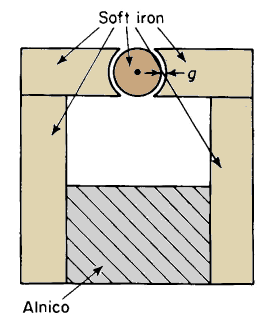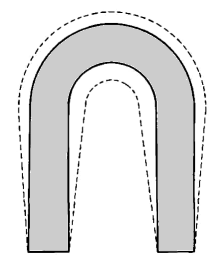| Capacitors, Magnetic Circuits, and Transformers is a free introductory textbook on the physics of capacitors, coils, and transformers. See the editorial for more information.... |

|

Home  Magnetic Circuits Magnetic Circuits  Permanent Magnets Permanent Magnets |
|||||






|
|||||
Permanent Magnets
There are two general kinds of magnetic materials, namely those that are magnetically soft and those that are magnetically hard. The magnetically soft materials are easy to magnetize and generally have low residual flux density, i.e., they retain a relatively small amount of magnetic flux when the applied magnetizing force is removed. Such materials are not suitable for permanent magnets. The magnetically hard materials are more difficult to magnetize and have high residual flux density and are capable of maintaining appreciable flux in the presence of relatively strong external demagnetizing forces. Permanent magnets have many applications. In some applications the magnet exerts a force on other magnetic members; in other applications the field that the magnet maintains external to itself is used to influence the path of electrons flowing in a vacuum, a gas, or in a conductor, thus converting electrical energy into mechanical energy. The following are typical examples of permanent magnet applications: magnetic clutches and couplings, loud speakers, generators, television focusing units, magnetrons, measuring instruments, relays, information storage in computers and in video recording, etc. Methods of magnetizing magnets depend upon the shape of the magnet. Magnets in the form of a straight bar are usually magnetized by placing them between the poles of a powerful electromagnet. When the magnets are U-shaped or circular they may be magnetized individually or in groups by placing a conductor through their centers and applying a current surge of several thousand amperes to the conductor. During this procedure the air gap of each magnet is short-circuited magnetically by bridging it with a soft iron bar so that practically all of the applied mmf is expended on the reluctance of the permanent magnet material. Removal of the bridging piece of iron causes a reduction in the flux of the magnet. If the air gap is again closed there is an increase in the flux but not to the value that it had before the bridging iron was initially removed. No appreciable permanent change occurs in the flux upon subsequent opening and reclosing of the air gap.
Carbon steel, chrome, tungsten magnet, and cobalt magnet steels have been used in permanent magnets for many years and are still used to some extent. These materials have now been largely replaced by carbon-free magnet alloys. The most widely used alloy of this type is of the nickel-aluminum-iron group known as Alnico. Although these latter materials are difficult to machine, they come in a variety of sizes and shapes. In many cases the most economical design is one in which the permanent magnet material is arranged in a simple shape so as to require a minimum of machining (or rather grinding) and to provide the magnet with soft iron pole pieces that can be readily machined to the desired shape. The magnetic circuit of an indicating instrument that makes use of Alnico in combination with soft iron parts is shown in Fig. 3-27. Common shapes of Alnico magnets are rods, bars, and U-shapes, although there are numerous other shapes as well. Figure 3-28 shows a U-shaped magnet. Since the magnet is generally required to produce flux through an air gap, the space between the vertical sections is in parallel with the air gap and provides a leakage path. As a result the flux must be greater in the part of the magnet away from the poles (at the open ends) than it is in the vicinity of the poles. In order to provide for more nearly uniform flux density in the magnet material, the area carrying the greater amount of flux is built up as shown by the broken lines in Fig. 3-28.
|
|||||
Home  Magnetic Circuits Magnetic Circuits  Permanent Magnets Permanent Magnets |
|||||
Last Update: 2011-02-16



